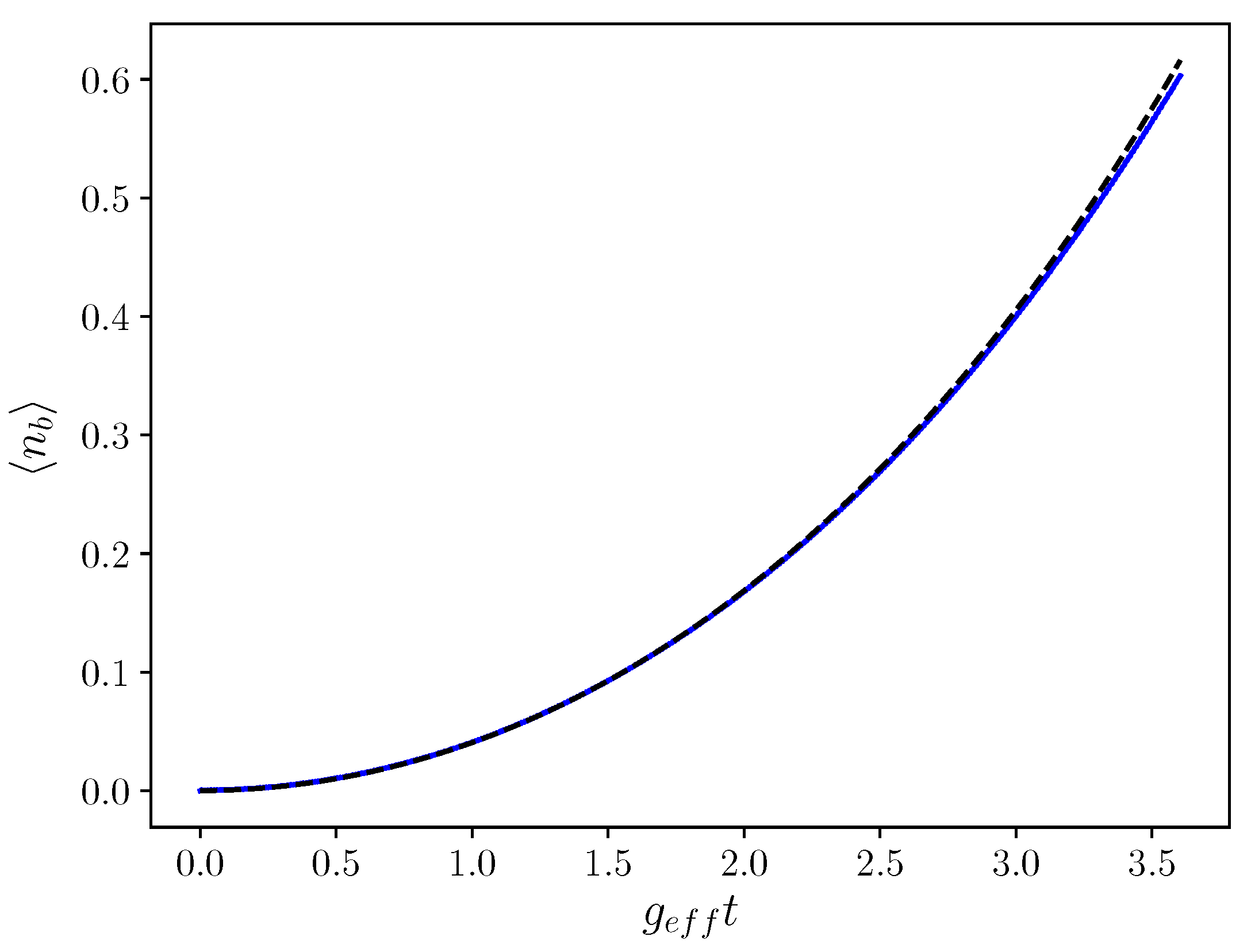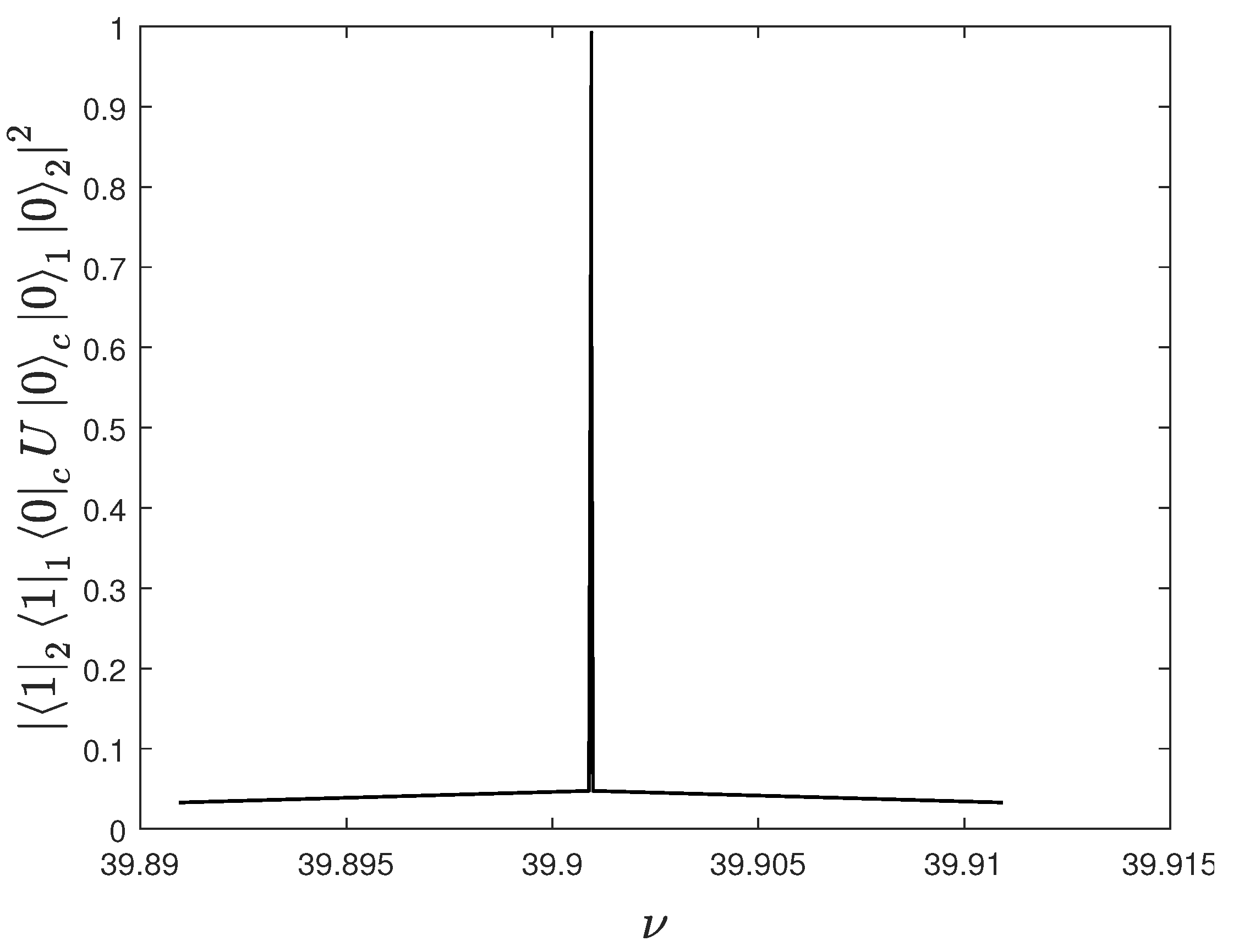Effective and Efficient Resonant Transitions in Periodically Modulated Quantum Systems
Abstract
1. Introduction
2. Single Periodically Modulated Quantum System
2.1. General Settings
2.2. Effective Hamiltonian,
2.3. Examples
2.3.1. Semi-Classical Rabi Model
2.3.2. Quantum Parametric Oscillator
2.4. Effective Hamiltonian,
2.5. Modulated Quantum System with Intensity Dependent Coupling
3. Two Periodically Modulated Coupled Quantum Systems
- (i)
- Both X and Y systems are described by the algebra. In this case is a linear form on ;
- (ii)
- One of the systems is described by and another by algebra. In this case the leading term in is a second degree polynomial on and , and the first correction is of a third degree one;
- (iii)
- The leading term in is a third degree polynomial if both systems have symmetry.
3.1. Modulated Quantum Parametric Amplifier
3.1.1. Dicke Model with Modulated Frequency
3.1.2. Non-Symmetric Excitation of an Atomic System in a Vacuum Field
4. Conclusions
Author Contributions
Funding
Conflicts of Interest
Appendix A. Single Periodically Modulated Quantum System
Appendix A.1. Frequency Corrections
Appendix B. Two Coupled Systems with Modulated Frequency
| Interaction | ||
|---|---|---|
Appendix B.1. Non-Symmetric Excitation of an Atomic System in a Vacuum
References
- Autler, S.H.; Townes, C.H. Stark Effect in Rapidly Varying Fields. Phys. Rev. 1995, 100, 703–722. [Google Scholar] [CrossRef]
- Shirley, J.H. Solution of the Schrödinger Equation with a Hamiltonian Periodic in Time. Phys. Rev. 1965, 138, B979–B987. [Google Scholar] [CrossRef]
- Margerie, J.; Brossel, J. Transitions à plusieurs quanta électromagnétiques. Acad. Sci. 1955, 241, 373. [Google Scholar]
- Yabuzaki, T.; Nakayama, S.; Murakami, Y.; Ogawa, T. Interaction between a spin-1/2 atom and a strong rf field. Phys. Rev. A 1974, 10, 241–243. [Google Scholar] [CrossRef]
- Grossmann, F.; Dittrich, T.; Jung, P.; Hänggi, P. Coherent destruction of tunneling. Phys. Rev. Lett. 1991, 67, 516–519. [Google Scholar] [CrossRef] [PubMed]
- Dakhnovskii, Y.; Metiu, H. Conditions leading to intense low-frequency generation and strong localization in two-level systems. Phys. Rev. A 1993, 48, 2342–2345. [Google Scholar] [CrossRef]
- Zhao, X.G. Quasienergy and Floquet states in a time-periodic driven two-level system. Phys. Rev. B 1994, 49, 16753–16756. [Google Scholar] [CrossRef] [PubMed]
- Wang, H.; Freire, V.N.; Zhao, X.G. Emission spectrum in driven two-level systems. Phys. Rev. A 1998, 58, 1531–1536. [Google Scholar] [CrossRef]
- Seideman, T.J. New means of spatially manipulating molecules with light. Chem. Phys. 1999, 111, 4397–43405. [Google Scholar] [CrossRef]
- Larsen, J.J.; Hald, K.; Bjerre, N.; Stapelfeld, H.; Seideman, T.J. Three dimensional alignment of molecules using elliptically polarized laser fields. Phys. Rev. Lett. 2000, 85, 2470–2473. [Google Scholar] [CrossRef]
- Dey, B.K.; Shapiro, M.; Brumer, P. Coherently controlled nanoscale molecular deposition. Phys. Rev. Lett. 2000, 85, 3125–3128. [Google Scholar] [CrossRef] [PubMed]
- Stapelfeld, H.; Seideman, T. Colloquium: Aligning molecules with strong laser pulses. Rev. Mod. Phys. 2003, 75, 543–557. [Google Scholar] [CrossRef]
- Martinez, D.F. Floquet–Green function formalism for harmonically driven Hamiltonians. J. Phys. A Math. Gen. 2003, 36, 9827–9842. [Google Scholar] [CrossRef]
- Creffield, C.E. Location of crossings in the Floquet spectrum of a driven two-level system. Phys. Rev. B 2003, 67, 165301. [Google Scholar] [CrossRef]
- Yan, Y.; Lü, Z.; Zheng, H. Bloch-Siegert shift of the Rabi model. Phys. Rev. A 2015, 91, 053834. [Google Scholar] [CrossRef]
- Huang, J.F.; Liao, J.Q.; Tian, L.; Kuang, L.M. Manipulating counter-rotating interactions in the quantum Rabi model via modulation of transition frequency of the two-level system. Phys. Rev. A 2017, 96, 043849. [Google Scholar] [CrossRef]
- Zhao, Y.J.; Liu, Y.L.; Liu, Y.X.; Nori, F. Generating nonclassical photon states via longitudinal couplings between superconducting qubits and microwave fields. Phys. Rev. A 2015, 91, 053820. [Google Scholar] [CrossRef]
- Casanova, J.; Puebla, R.; Moya-Cessa, H.; Plenio, M.B. Connecting nth order generalised quantum Rabi models: Emergence of nonlinear spin-boson coupling via spin rotations. NPJ Quantum Inf. 2018, 4, 1–7. [Google Scholar] [CrossRef]
- Pietikäinen, I.; Danilin, S.; Kumar, K.S.; Vepsäläinen, A.; Golubev, D.S.; Tuorila, J.; Paraoanu, G.S. Observation of the Bloch-Siegert shift in a driven quantum-to-classical transition. Phys. Rev. B 2017, 96, 020501(R). [Google Scholar] [CrossRef]
- Navarrete-Benllochi, C.; García-Ripoll, J.J.; Porras, D. Inducing Nonclassical Lasing via Periodic Drivings in Circuit Quantum Electrodynamics. Phys. Rev. Lett. 2014, 113, 193601. [Google Scholar] [CrossRef] [PubMed]
- Wang, G.; Xiao, R.; Shen, H.Z.; Sun, C.; Xue, K. Simulating Anisotropic quantum Rabi model via frequency modulation. Sci. Rep. 2019, 9, 1–10. [Google Scholar] [CrossRef] [PubMed]
- Hoeb, F.; Angaroni, F.; Zoller, J.; Calarco, T.; Strini, G.; Montangero, S.; Benenti, G. Amplification of the parametric dynamical Casimir effect via optimal control. Phys.Rev. A 2017, 96, 033851. [Google Scholar] [CrossRef]
- Dodonov, A.V. Dynamical Casimir effect via four- and five-photon transitions using a strongly detuned atom. Phys. Rev. A 2019, 100, 032510. [Google Scholar] [CrossRef]
- Louisell, W.H.; Yariv, A.; Siegman, A.E. Quantum Fluctuations and Noise in Parametric Processes. I. Phys. Rev. 1961, 124, 1646–1654. [Google Scholar] [CrossRef]
- Klimov, A.B.; Sainz, I.; Chumakov, S.M. Resonance expansion versus the rotating-wave approximation. Phys. Rev. A 2003, 68, 063811. [Google Scholar] [CrossRef]
- Ma, K.K.W.; Law, C.K. Three-photon resonance and adiabatic passage in the large-detuning Rabi model. Phys. Rev. A 2015, 92, 023842. [Google Scholar] [CrossRef]
- Sokolov, A.M.; Stolyarov, E.V. Single-photon switch controlled by a qubit embedded in an engineered electromagnetic environment. Phys. Rev. A 2020, 102, 042306. [Google Scholar] [CrossRef]
- Garziano, L.; Macrì, V.; Stassi, R. One Photon Can Simultaneously Excite Two or More Atoms. Phys. Rev. Lett. 2016, 117, 043601. [Google Scholar] [CrossRef] [PubMed]
- Niemczyk, T.; Deppe, F.; Huebl, H.; Menzel, E.P.; Hocke, F.; Schwarz, M.J.; Garcia-Ripoll, J.J.; Zueco, D.; Hümmer, T.; Solano, E.; et al. Circuit quantum electrodynamics in the ultrastrong-coupling regime. Nature Phys. 2010, 6, 772–776. [Google Scholar] [CrossRef]
- Schoelkopf, R.J.; Girvin, S.M. Wiring up quantum systems. Nature 2008, 451, 664–669. [Google Scholar] [CrossRef] [PubMed]
- You, J.; Nori, F. Atomic physics and quantum optics using superconducting circuits. Nature 2011, 474, 589–597. [Google Scholar] [CrossRef]
- Blais, A.; Grimsmo, A.L.; Girvin, S.M.; Wallraff, A. Circuit Quantum Electrodynamics. arXiv 2020, arXiv:2005.12667v1. [Google Scholar]
- Klimov, A.B.; Sánchez-Soto, L.L. Method of small rotations and effective Hamiltonians in nonlinear quantum optics. Phys. Rev. A 2000, 61, 068302. [Google Scholar] [CrossRef]
- Klimov, A.B.; Sánchez-Soto, L.L.; Navarro, A.; Yustas, E.C. Effective Hamiltonians in quantum optics: A systematic approach. J. Mod. Opt. 2002, 49, 2211–2226. [Google Scholar] [CrossRef]
- Sainz, I.; Klimov, A.B.; Saavedra, C. Effective Hamiltonian approach to periodically perturbed quantum optical systems. Phys. Lett. A 2006, 351, 26–30. [Google Scholar] [CrossRef]
- Comtet, L. Advanced Combinatorics; Riedel, D., Ed.; Publishing Co.: Dordrecht, The Netherlands, 1974. [Google Scholar]
- Karassiov, V.P. G-invariant polynomial extensions of Lie algebras in quantum many-body physics. J. Phys. A Math. Gen. 1994, 27, 153. [Google Scholar] [CrossRef]
- Karassiov, V.P.; Klimov, A.B. An algebraic approach for solving evolution problems in some nonlinear quantum models. Phys. Lett. A 1994, 191, 117. [Google Scholar] [CrossRef]
- Lee, Y.-H.; Yang, W.-L.; Zhang, Y.-Z. Polynomial algebras and exact solutions of general quantum nonlinear optical models I: Two-mode boson systems. J. Phys. A Math. Theor. 2010, 43, 185204. [Google Scholar] [CrossRef]
- Graefe, E.-M.; Korsch, H.J.; Rush, A. Classical-quantum correspondence in bosonic two-mode conversion systems: Polynomial algebras and Kummer shapes. Phys. Rev. A 2016, 93, 042102. [Google Scholar] [CrossRef]
- Roy, A.; Devoret, M. Introduction to Quantum-limited Parametric Amplification of Quantum Signals with Josephson Circuits. Comptes Rendus Phys. 2016, 17, 740–755. [Google Scholar] [CrossRef]
- Chen, Z.; Wang, Y.; Li, T.; Qiu, Y.; Inomata, K.; Yoshihara, F.; Han, S.; Nori, F.; Tsai, J.S.; You, J.Q. Single-photon-driven high-order sideband transitions in an ultrastrongly coupled circuit-quantum-electrodynamics system. Phys. Rev. A 2017, 96, 012325. [Google Scholar] [CrossRef]
- Dodonov, A.V.; Dodonov, V.V. Dynamical Casimir effect in two-atom cavity QED. Phys. Rev. A 2012, 85, 055805. [Google Scholar] [CrossRef]




| Interactions | ||
|---|---|---|
| g | ||
| Interaction | ||
|---|---|---|
Publisher’s Note: MDPI stays neutral with regard to jurisdictional claims in published maps and institutional affiliations. |
© 2021 by the authors. Licensee MDPI, Basel, Switzerland. This article is an open access article distributed under the terms and conditions of the Creative Commons Attribution (CC BY) license (http://creativecommons.org/licenses/by/4.0/).
Share and Cite
Sainz, I.; García, A.; Klimov, A.B. Effective and Efficient Resonant Transitions in Periodically Modulated Quantum Systems. Quantum Rep. 2021, 3, 173-195. https://doi.org/10.3390/quantum3010011
Sainz I, García A, Klimov AB. Effective and Efficient Resonant Transitions in Periodically Modulated Quantum Systems. Quantum Reports. 2021; 3(1):173-195. https://doi.org/10.3390/quantum3010011
Chicago/Turabian StyleSainz, Isabel, Andrés García, and Andrei B. Klimov. 2021. "Effective and Efficient Resonant Transitions in Periodically Modulated Quantum Systems" Quantum Reports 3, no. 1: 173-195. https://doi.org/10.3390/quantum3010011
APA StyleSainz, I., García, A., & Klimov, A. B. (2021). Effective and Efficient Resonant Transitions in Periodically Modulated Quantum Systems. Quantum Reports, 3(1), 173-195. https://doi.org/10.3390/quantum3010011






